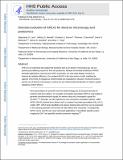Directed evolution of APEX2 for electron microscopy and proximity labeling
Author(s)
Kamer, Kimberli J; Deerinck, Thomas J; Ellisman, Mark H; Mootha, Vamsi K; Lam, Stephanie Shih-Min; Martell, Jeffrey Daniel; Ting, Alice Y; ... Show more Show less
DownloadTing_Directed evolution.pdf (2.078Mb)
PUBLISHER_POLICY
Publisher Policy
Article is made available in accordance with the publisher's policy and may be subject to US copyright law. Please refer to the publisher's site for terms of use.
Terms of use
Metadata
Show full item recordAbstract
APEX is an engineered peroxidase that functions as an electron microscopy tag and a promiscuous labeling enzyme for live-cell proteomics. Because limited sensitivity precludes applications requiring low APEX expression, we used yeast-display evolution to improve its catalytic efficiency. APEX2 is far more active in cells, enabling the use of electron microscopy to resolve the submitochondrial localization of calcium uptake regulatory protein MICU1. APEX2 also permits superior enrichment of endogenous mitochondrial and endoplasmic reticulum membrane proteins.
Date issued
2014-11Department
Massachusetts Institute of Technology. Department of ChemistryJournal
Nature Methods
Publisher
Nature Publishing Group
Citation
Lam, Stephanie S; Martell, Jeffrey D; Kamer, Kimberli J et al. "Directed evolution of APEX2 for electron microscopy and proximity labeling." Nature Methods 12, 1: 51–54 (January 2015) © 2015 Nature America, Inc
Version: Author's final manuscript
ISSN
1548-7091
1548-7105